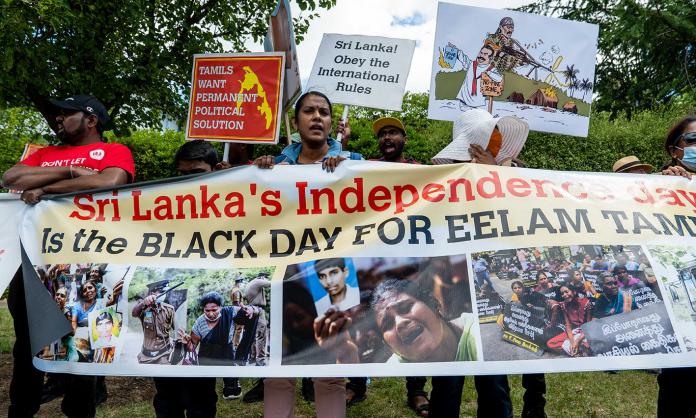From the moment Sri Lanka gained independence from British colonial rule in 1948, Tamils in the country faced increasing marginalisation. Successive governments, dominated by the Sinhalese-Buddhist ethnic majority (about 80 percent of the population), passed discriminatory laws targeting higher education, government hiring and language and voting rights—a systematic attempt to erode the foundations of Tamils’ national life through colonisation, economic strangulation and, more recently, one of the most intense military occupations in the world.
Although they are an overall minority, Tamils are the majority in the north and the east of the island. Mirjam Weiberg-Salzmann, from the University of Münster in Germany, has explained the growing chauvinism of the Buddhist clerical order after the country’s independence, and an increasingly reactionary bond of religion, ethnicity and state power directed against Tamils:
“Whereas in the 1940s only a small minority of monks had been politically active, in the 1950s monks from all the Nikayas (sects of the order) became involved ... In the new history of Sri Lanka, the Tamils constituted a permanent and existential threat ... The sangha [Buddhist clerical order] demanded active steps for the protection of Buddhism and attempted to institutionalise the traditional connection between religion and politics ... The parliamentary elections of 1956 provided a large forum for the monks, which helped them spread their ideas.
“In the election campaign Tamils were branded parasites and the ‘death knell’ of the Buddhist Sinhalese, and hence a limited use of violence was supported ... Sinhalese was declared the sole national language. From the 1960s ‘Sinhalese’ and ‘Buddhist’ became synonymous terms, and religious activities became a necessary criterion for qualification to a political post and an indispensable element of election propaganda. State and nation were henceforth defined by (1) Buddhism, and (2) Sinhala-ness.”
The point is that religious extremism in Sri Lanka is not confined to marginal sects; it very early became a feature of government and a defining element of mainstream politics. The radical form of Sinhalese-Buddhist nationalism was codified in the 1972 republican constitution, which declared the country a “unitary state”, one in which only the Sinhalese could claim the right to self-determination.
“Sri Lanka means ‘Holy Ceylon’ and designates precisely the messianic chauvinism that is inseparable from Buddhism in the island”, the late international relations scholar Fred Halliday wrote in 1973. “For religiosity and racism cannot be dissociated in Ceylon: the local brand of Theravada Buddhism claims ... that the Sinhalese are a ‘chosen people’ and that Ceylon is their sacred island, divinely elected to its unique historical and spiritual destiny by Buddha himself. This wretched mystification naturally excludes the Tamils and other minorities from any equal role in national life.”
Successive Sri Lankan governments have adhered to this vision not only in theory, but in practice. Anti-Tamil pogroms in 1956, 1958, 1961, 1974, 1977, 1979, 1981 and 1983, resulted in thousands of Tamils murdered, raped, tortured and burned alive, all with the collusion of the Sri Lankan police, military and security forces. Tamil businesses were destroyed in the south and east of the island. Hundreds of thousands were displaced in their own country or made refugees internationally.
From the mid-1980s, the Tamil Tigers, an organisation built by radicalising Tamil youth, led a war for national liberation. The organisation was supported by an overwhelming majority of Tamils desperate for self-determination in their traditional homelands. The Tigers built a de facto state and were the de facto government in the north and the east of the island.
In 2008-09, after nearly 30 years of armed resistance to the Sinhala-Buddhist state’s project to destroy the Tamil nation, the Tigers were militarily defeated. Tens of thousands of civilians were murdered indiscriminately in a genocidal offensive by the Sri Lankan military. Thousands were disappeared on suspicion of being involved in the national liberation movement or for being members of the Tigers. These included social workers, teachers, police officers and more, as well as soldiers in the war.
More than ten years later, not one officer or political leader involved in ordering or carrying out the genocide has faced justice. They walk freely as national heroes. In fact, some are members of the current government. And the Sri Lankan state’s hostility remains. Tamils in traditional homelands are under surveillance and risk harassment or worse when they stand up for their rights. Importantly, the longstanding project of the Sinhalisation of Tamil areas continues – the process of demographically destroying the Tamil people’s claim to a geographically contiguous homeland that could be politically recognised.
The military is now deeply embedded in civilian and economic life in the north and east of the island. It even has a hand in running kindergartens for Tamil children. This is the greatest threat to most Tamils in their homelands: the disappearance of a nation under the boot of a chauvinist state. In this regard, their plight is analogous to other oppressed nations suffering at the hands of reactionary ruling classes that have developed chauvinist states within world imperialism—Palestinians at the hands of Israel, for example, or Kashmiris under the gun of Narendra Modi’s India.
The Australian and Sri Lankan governments claim that the country has moved on—that there are no longer valid reasons for most Tamils to claim asylum elsewhere. But the idea that genocide can be put to bed is both cruel and laughable.
There was no “settlement” between the Tamil Tigers and the Sri Lankan government, just a rout that wiped out the leadership, the leading cadres and tens of thousands of civilians. The military occupation since has been a consolidation of the Sri Lankan state’s gains.
A chauvinistic fervour continues to mark sections of the Sinhalese security forces. Mob violence has continued to blight the island. Torture, disappearance, rape and harassment continue to be weapons in an ongoing war against Tamil resistance to oppression. And Tamils still want self-determination.










